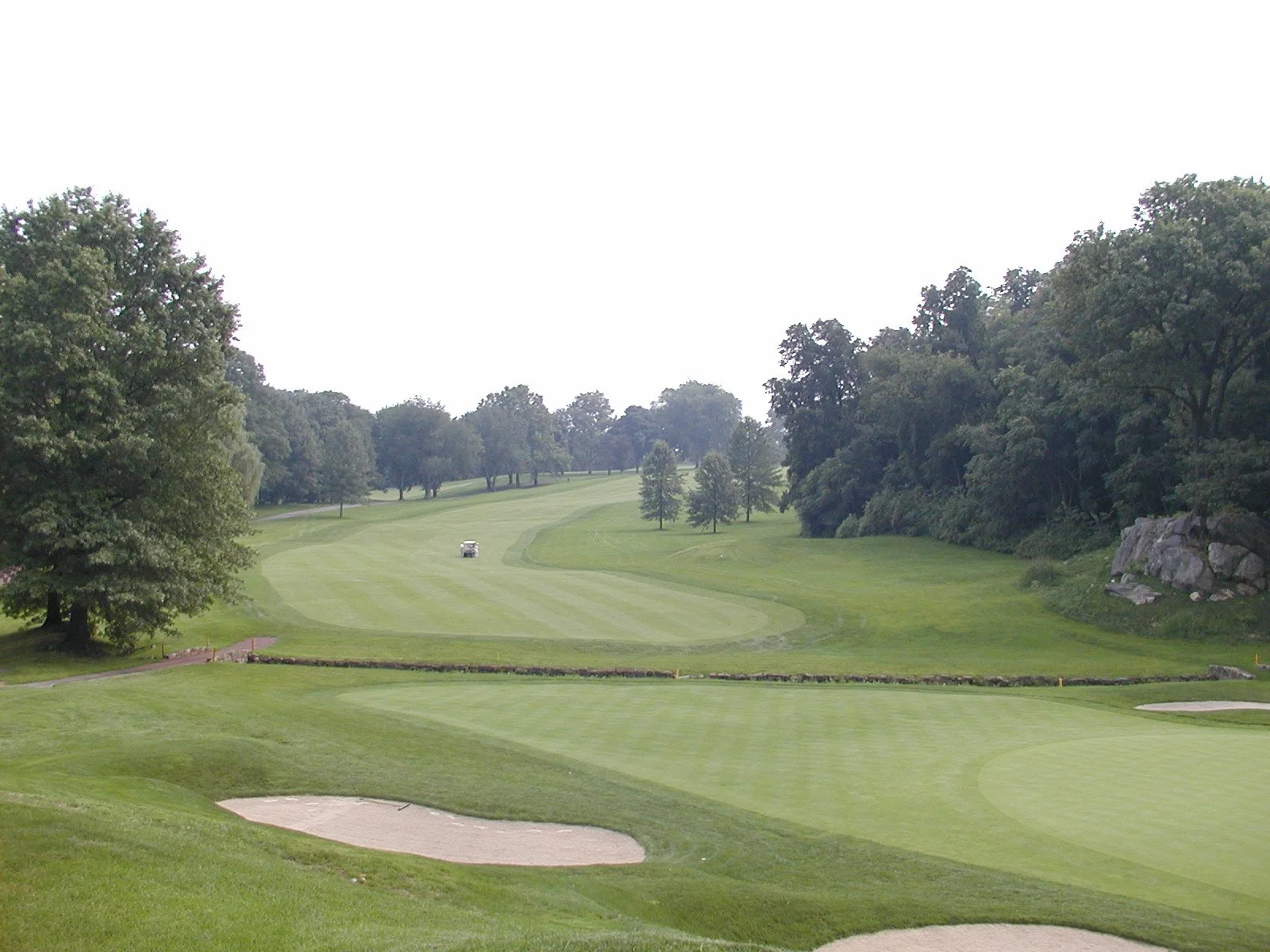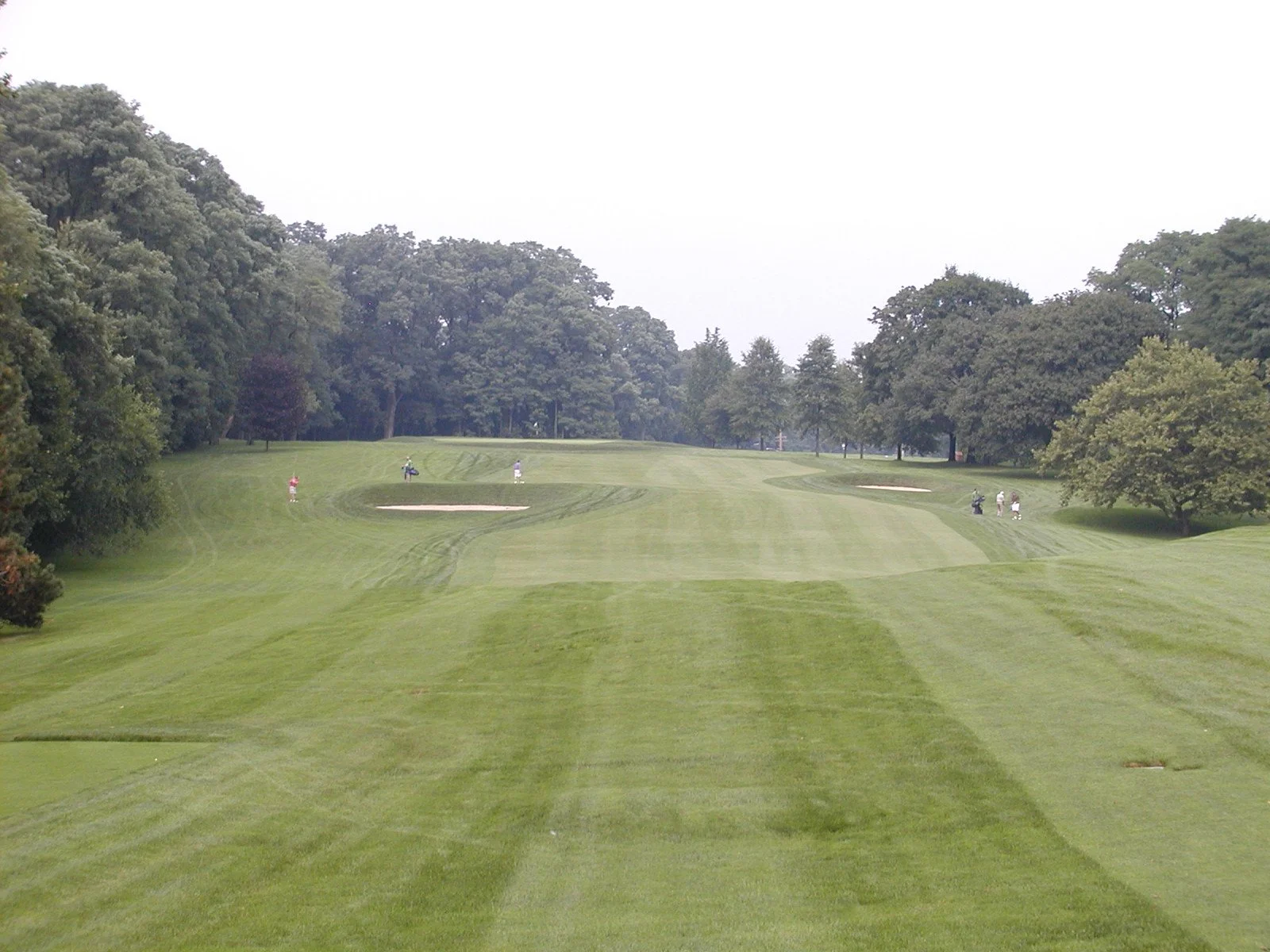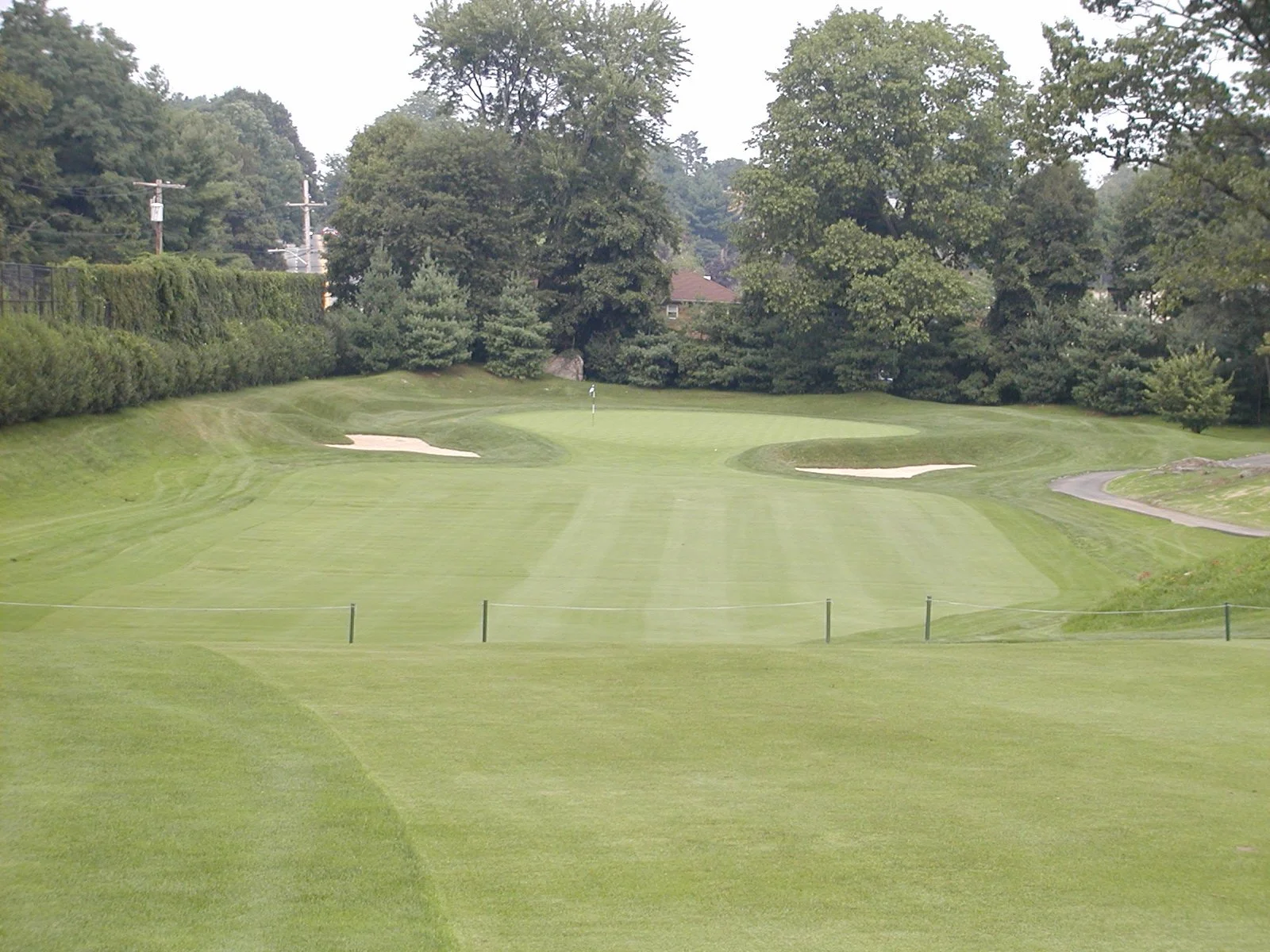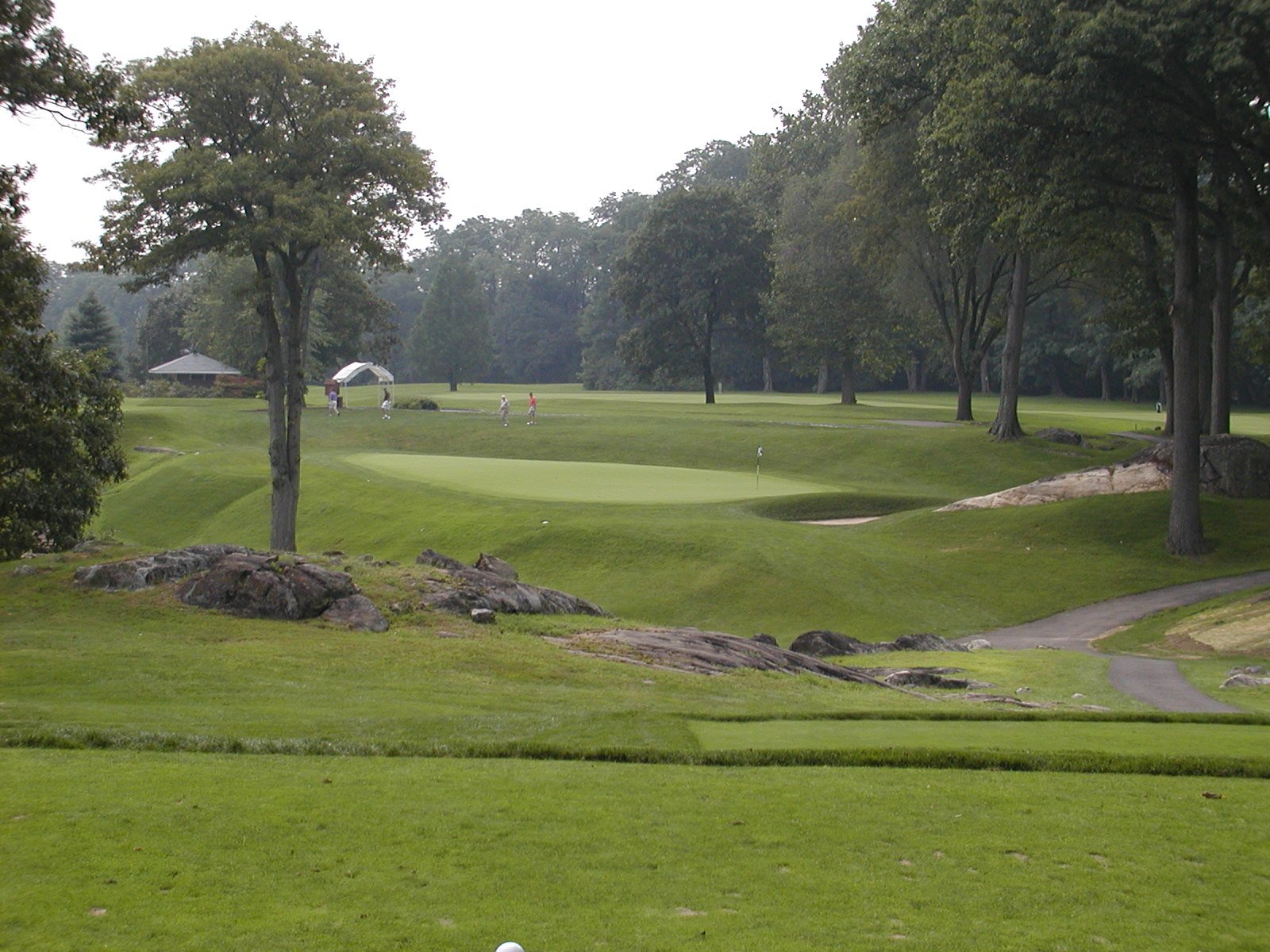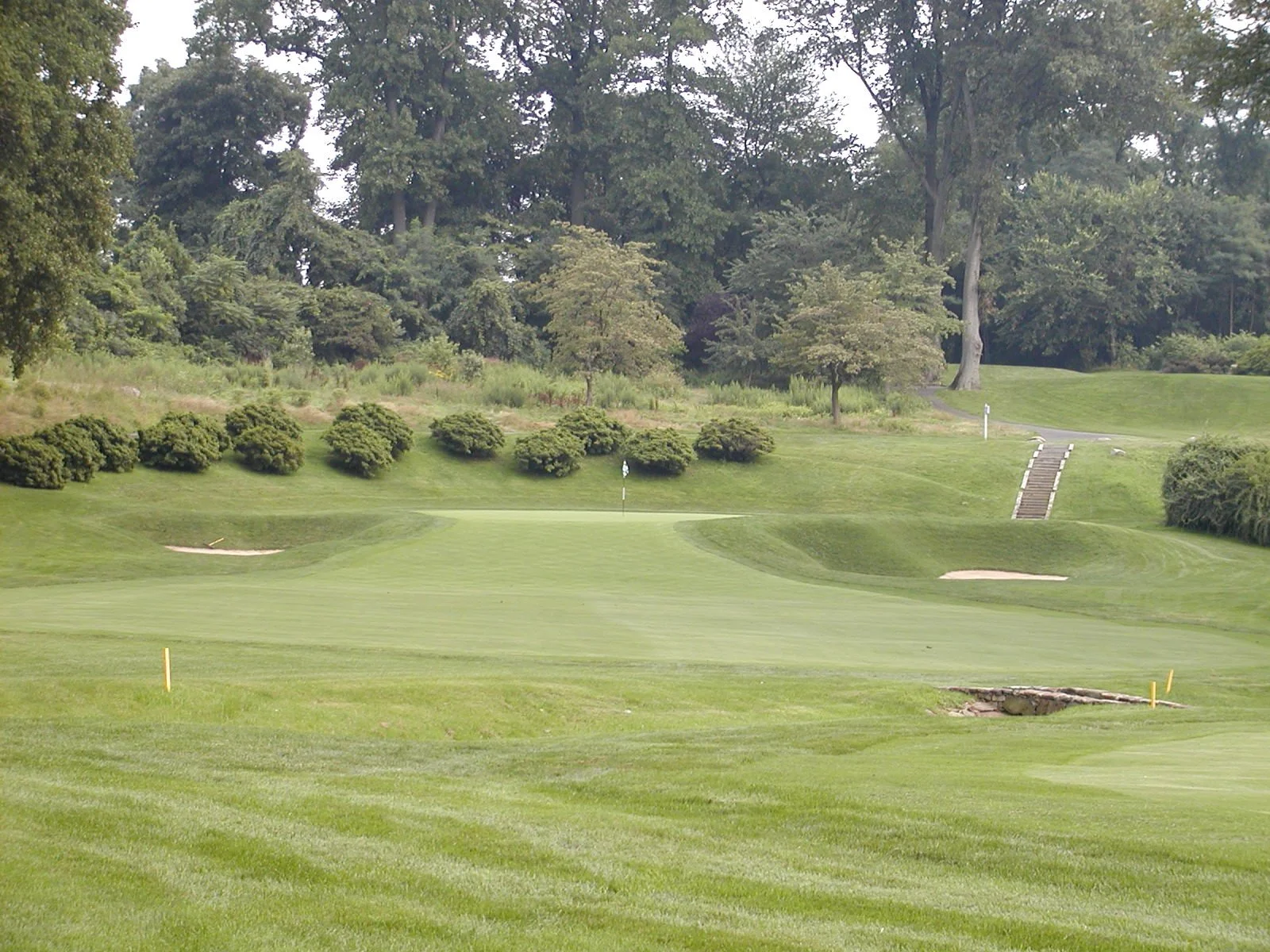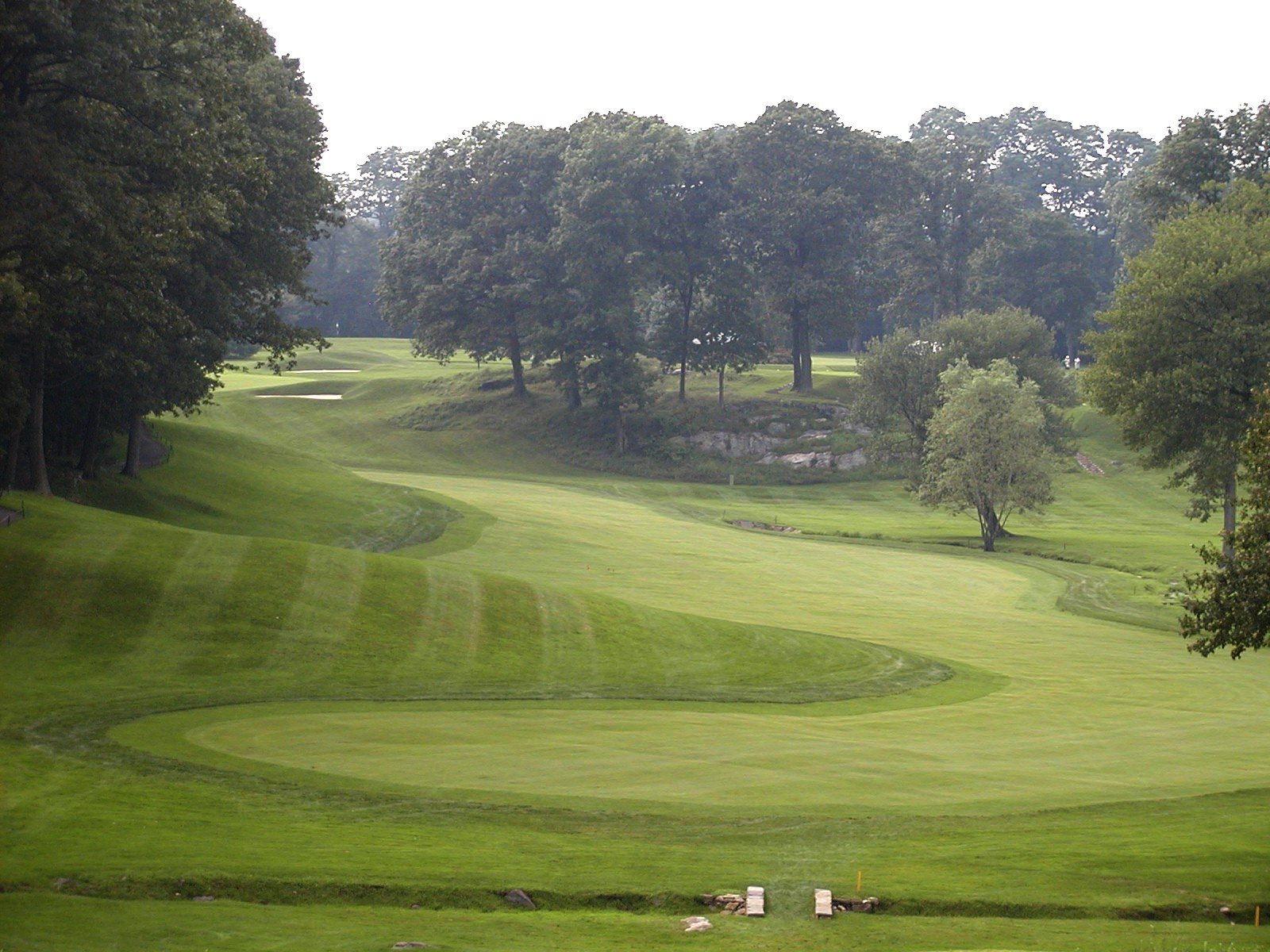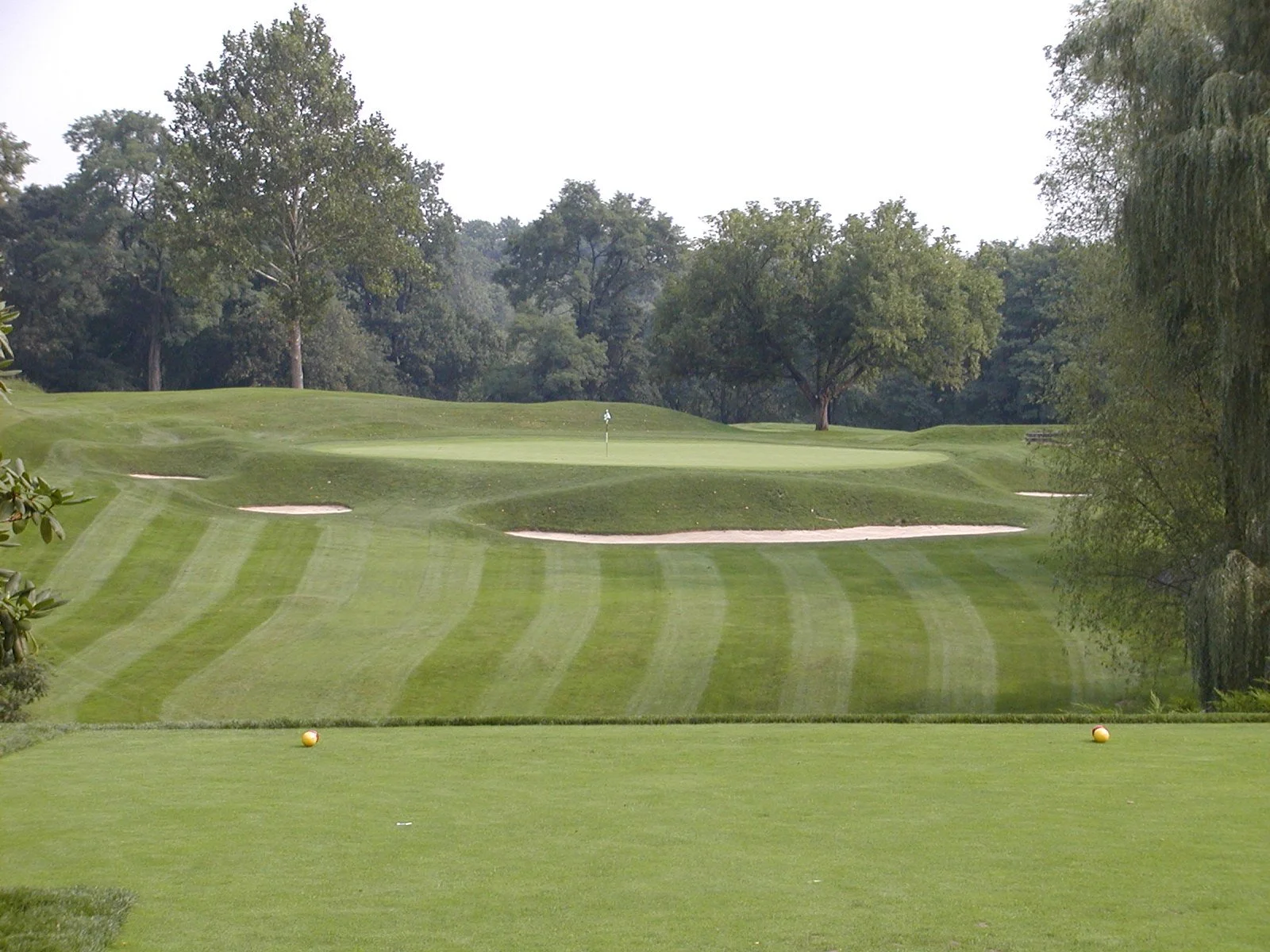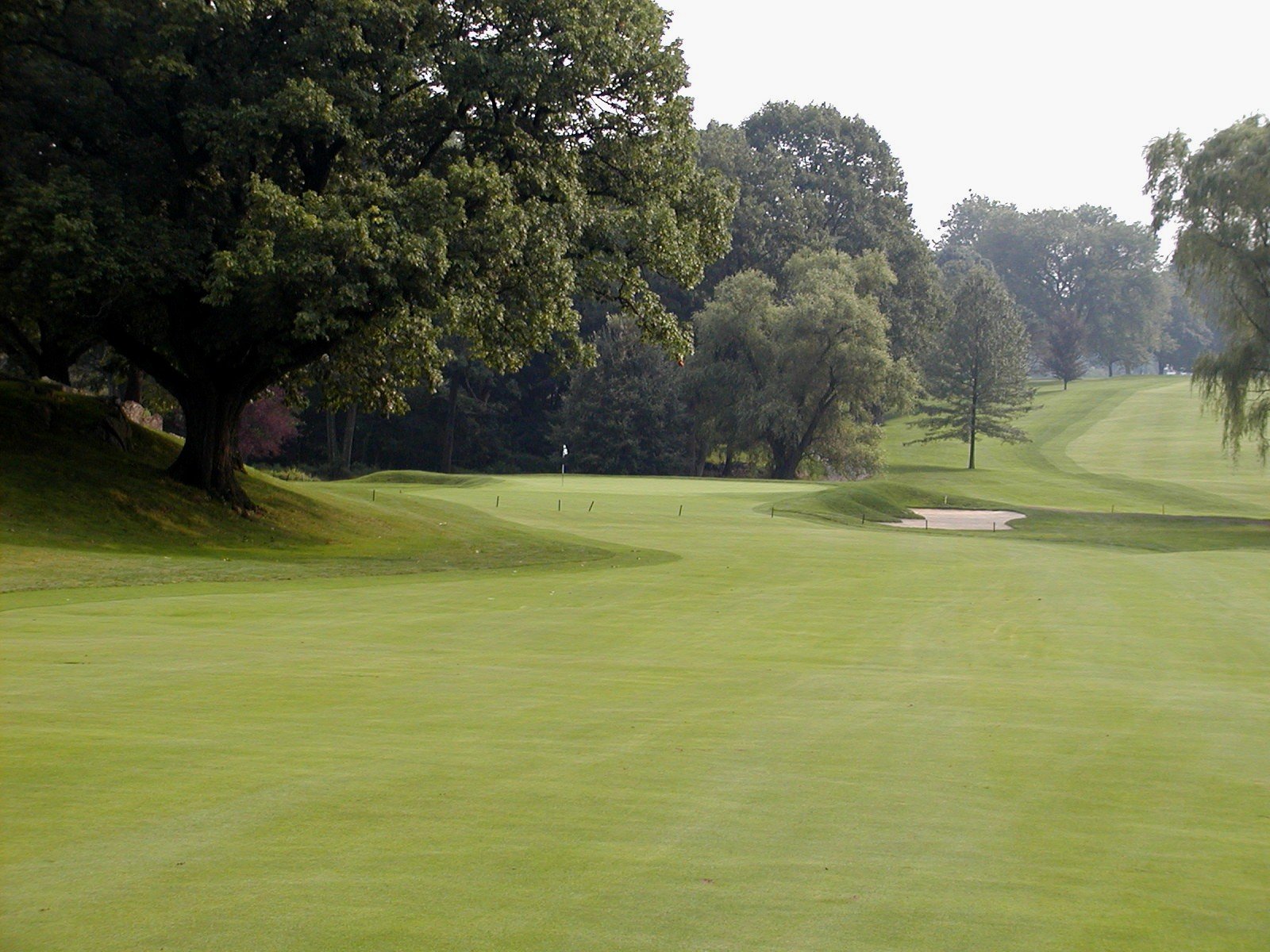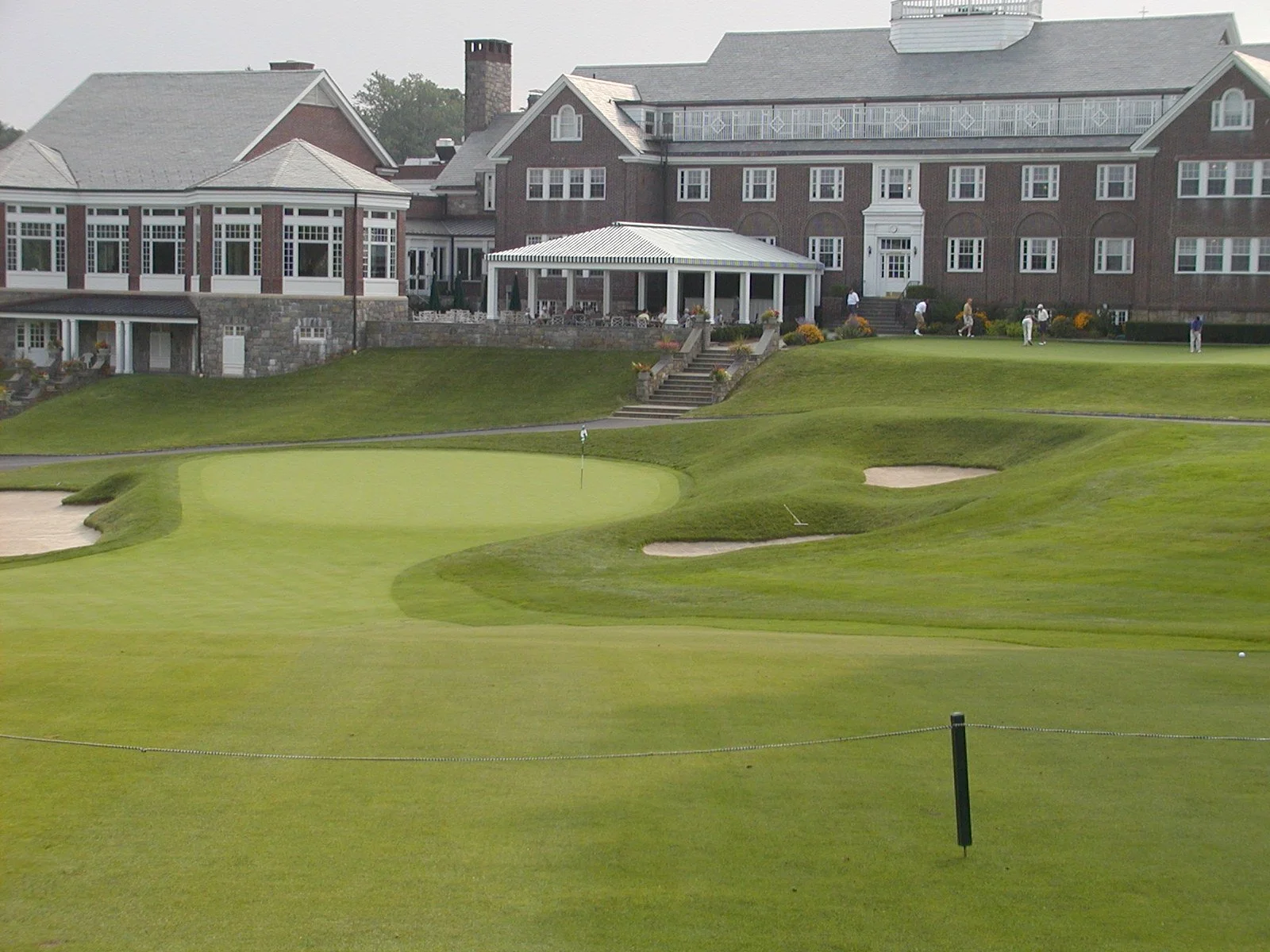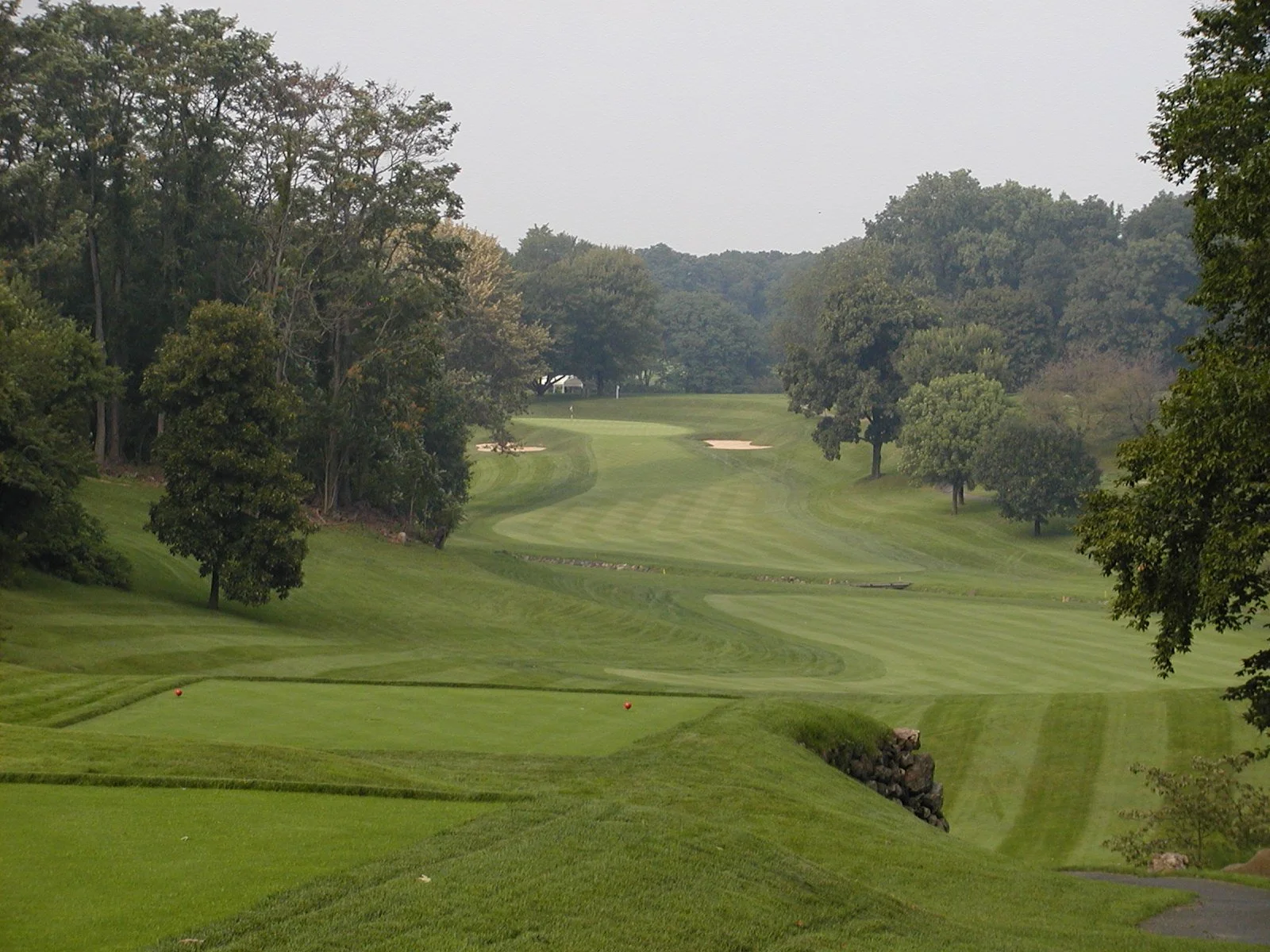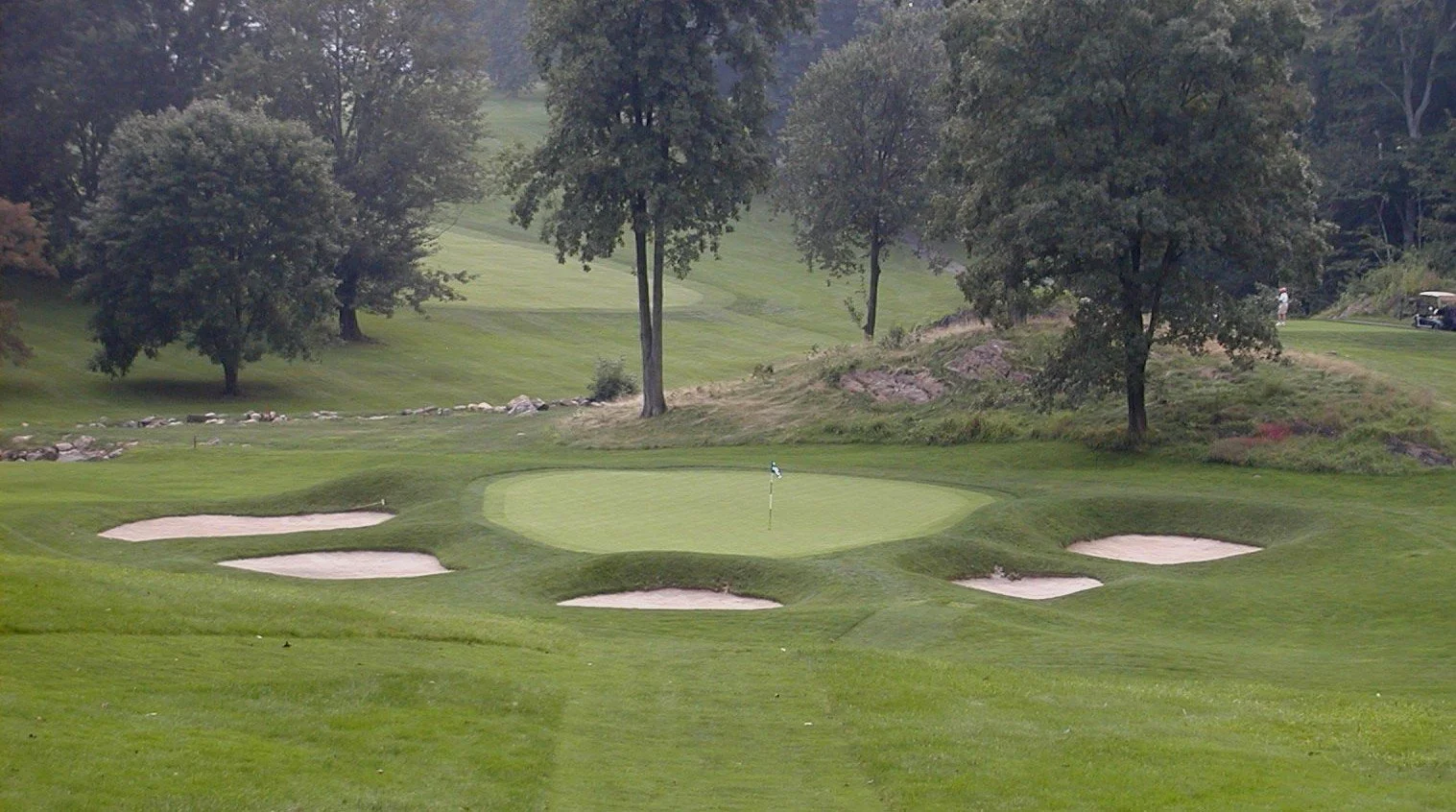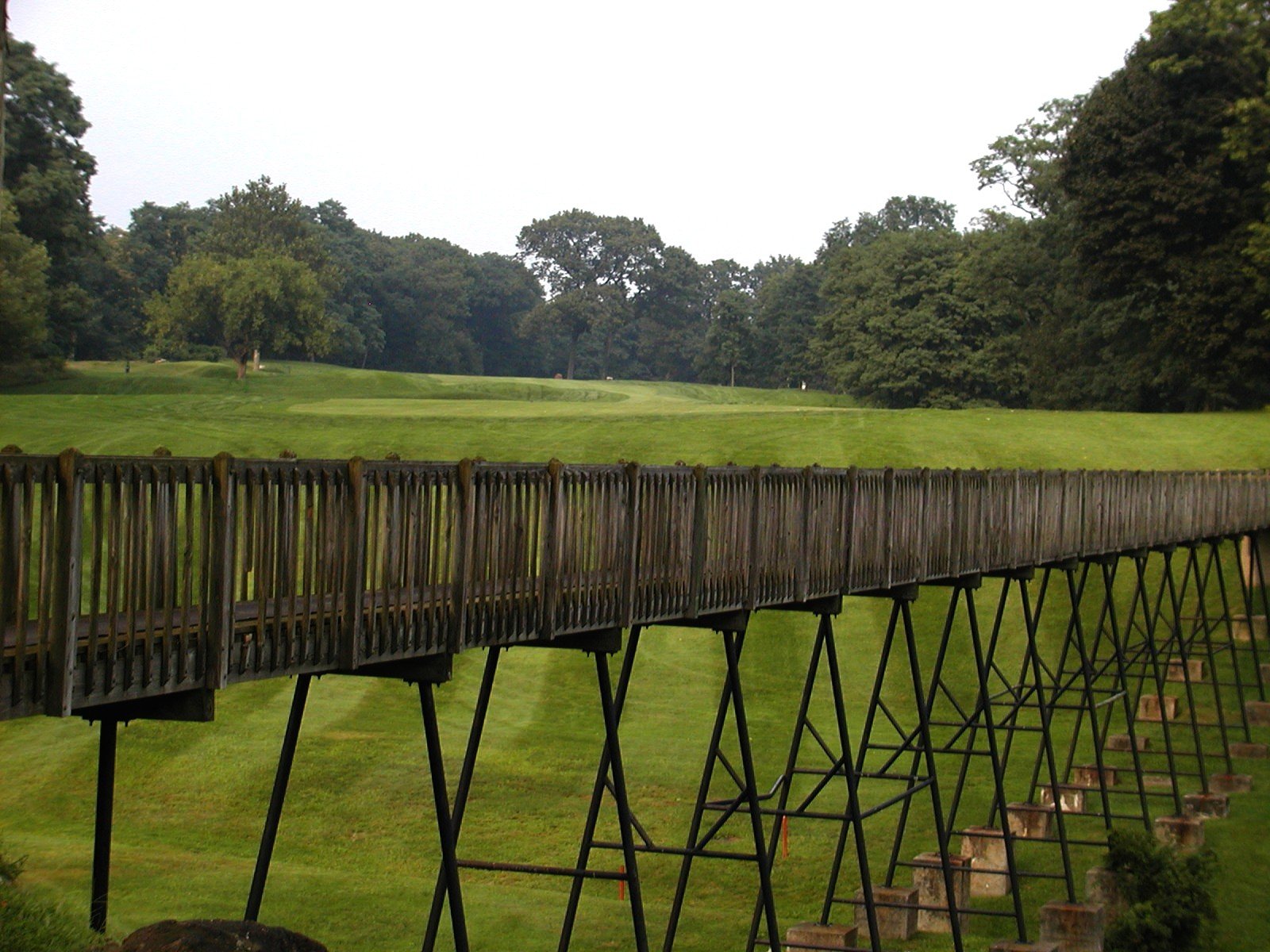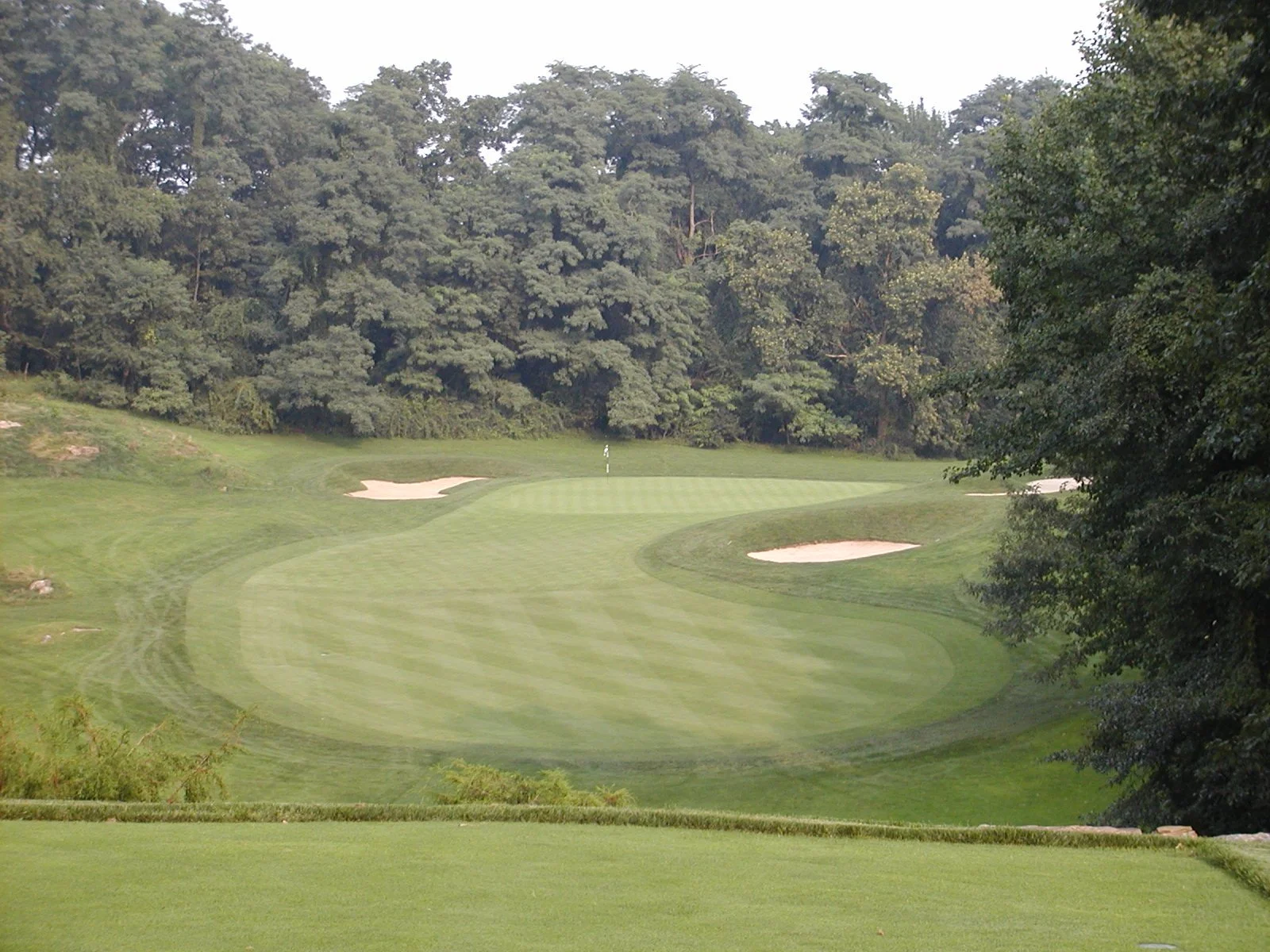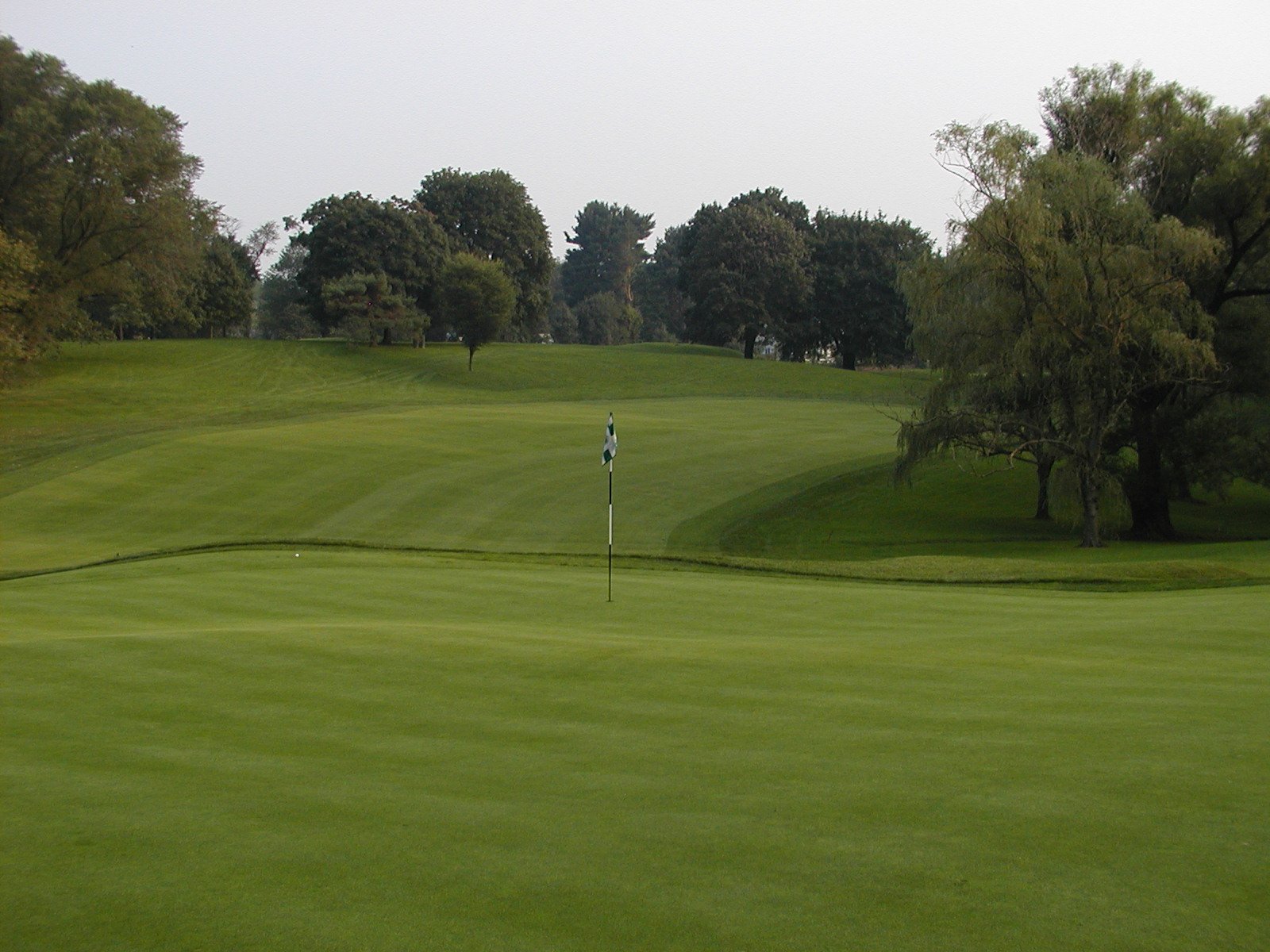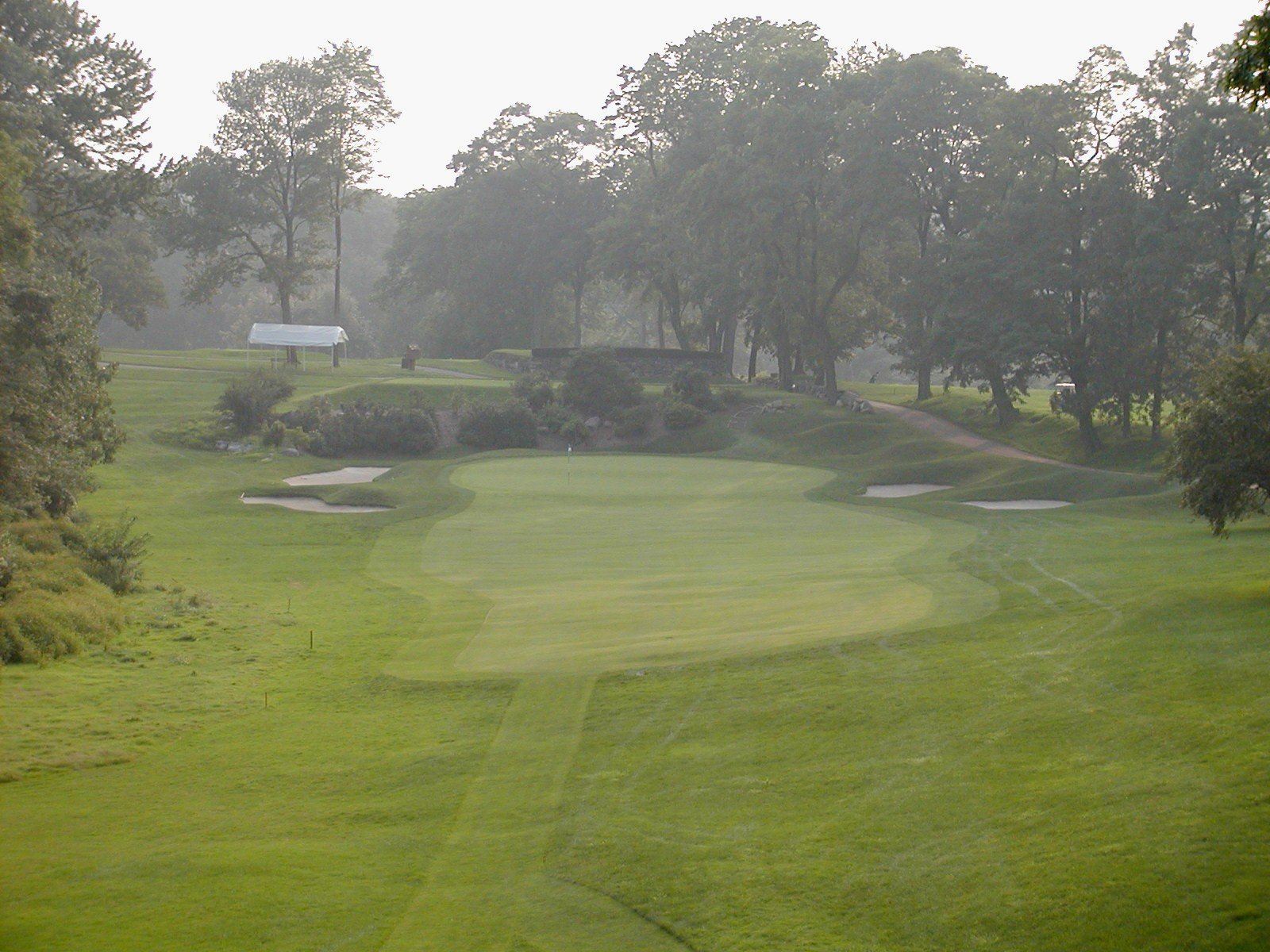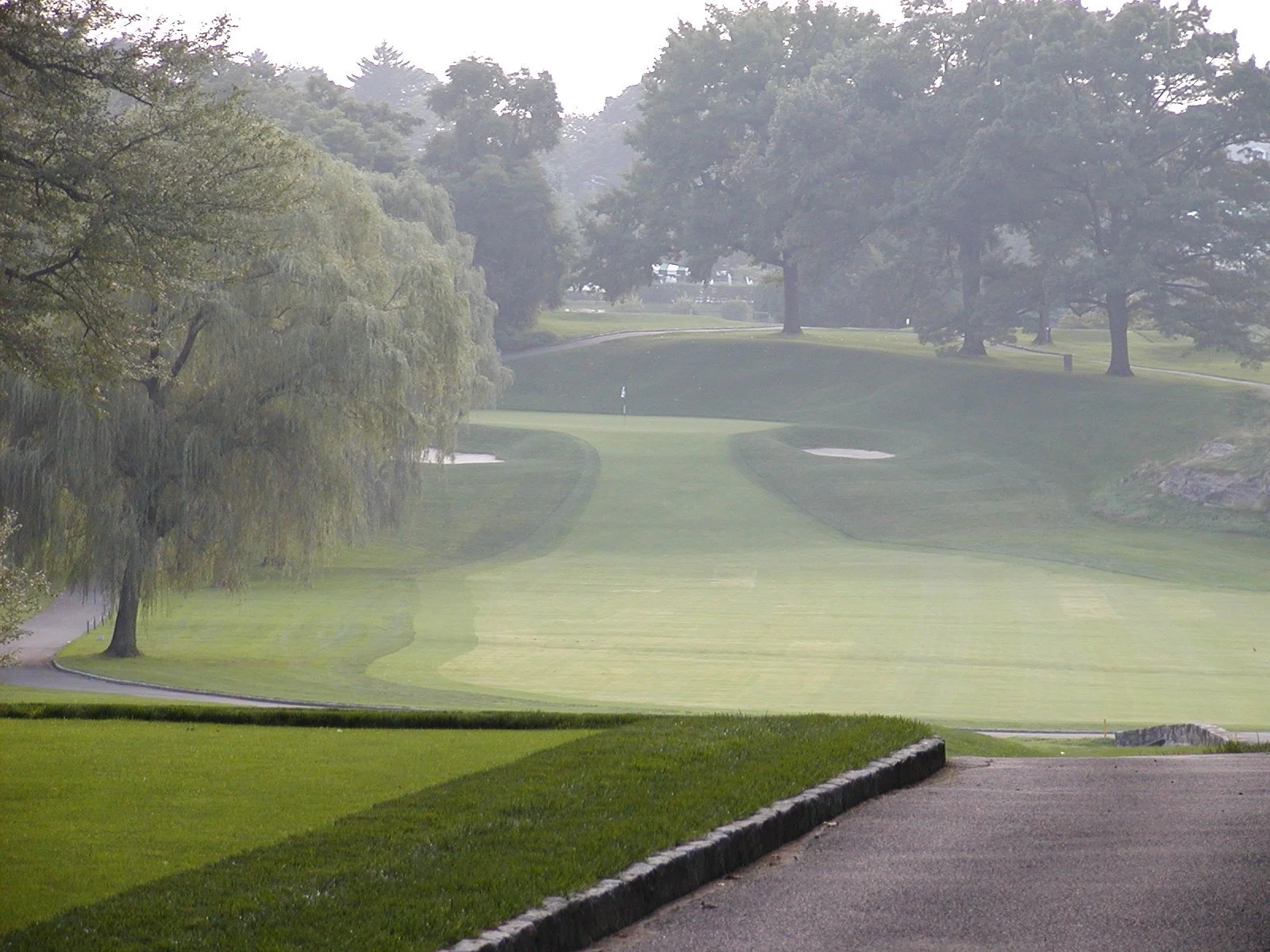WYKAGYL COUNTRY CLUB
Course Architects: Lawrence Van Etten (1904), Walter Travis (1908), Donald Ross (1920),
Tom Winton (1920), Robert White (1921-27), A.W. Tillinghast (1930),
Robert Trent Jones (1960), Hal Purdy (1963-70), Stephen Kay (1990),
Arthur Hills (1994), Bill Coore and Ben Crenshaw (2006)
Year Opened: 1904
Location: New Rochelle, New York
Slope: 138. Rating: 73.2
Par: 72
Yardage: 6,702
Hole-by-Hole: 1 - Par 5 540 Yds 10 - Par 5 517 Yds
2 - Par 4 399 Yds 11 - Par 3 164 Yds
3 - Par 4 431 Yds 12 - Par 5 496 Yds
4 - Par 3 147 Yds 13 - Par 3 210 Yds
5 - Par 4 400 Yds 14 - Par 4 407 Yds
6 - Par 5 528 Yds 15 - Par 4 362 Yds
7 - Par 3 172 Yds 16 - Par 3 226 Yds
8 - Par 4 452 Yds 17 - Par 4 374 Yds
9 - Par 5 500 Yds 18 - Par 4 377 Yds
Par 37 3,569 Yds Par 35 3,133 Yds
Key Events Held: The Met Open (1909, 1927),
Goodall, Palm Beach Round Robin (1948-52, 1956-57, 1964),
Triangle Round Robin (1961),
Girl Talk Classic (1976-77),
Golden Lights Championship (1978-80),
Chrysler-Plymouth Charity Classic (1982),
MasterCard International Pro-Am (1984),
JAL Big Apple Classic (1990-2000),
Sybase Big Apple Classic (2001-03),
Sybase Classic (2004-06),
HSBC World Match Play (2007).
Awards Won: Ranked #93 America's Top 100 Classic Courses by Golfweek (2004).
Website: www.wykagylcc.org
HISTORY: The President was William McKinley, the Gay Nineties were cooking, U.S. declares war on Spain over Cuba as Teddy Roosevelt and his Rough Riders charge up San Juan Hill leading the United States to victory in the Spanish-American War and famed composer George Gershwin was born. This all happened in the year 1898, when Wykagyl Country Club was founded, originally as Pelham Country Club. The club moved from its first location in Pelham to property in
New Rochelle, New York, where it was renamed Wykagyl Country Club after the Indian Tribe (Wikagyl).
Club member Lawrence E. Van Etten was chosen to design the course and in a short period of time, nine holes were fashioned at a cost of $2,100 and only a few months later the second nine was completed at a slightly greater cost ($4,560). The course played to a par of 71 at 6,326 yards. Rather quickly, the membership grew to 125 and by 1908, there were 450 members and as many as 520 the following year.
Over the seasons, Wykagyl hosted many events, including an exhibition in 1913, as Harry Vardon and Ted Ray played a match against Alex and Mac Smith. Despite a heavy downpour in the morning, 1,000 people came out for the match. The better-ball scores were 69-67 for the Smiths and 72-69 for Vardon and Ray. The match was held the day after the U.S. Open playoff in which Francis Ouimet defeated Vardon. Walter Hagen even came to Wykagyl one year
removed following his first U.S. Open title at the age of 21.
Legendary Bobby Jones visited Wykagyl for the first time in 1918, just two years after losing in the third round of the U.S. Amateur at 14. Jones returned in 1924, but along with partner Cyril Tolley, they lost 6 & 5 to "Long Jim" Barnes and Mike Brady.
One of the best architects at the time, Donald Ross was brought in to redesign the original fourth, fifth and sixth holes in 1920 while A.W. Tillinghast made additional changes in the early '30s to the same three holes and the 10th, 17th and 18th, as well as eliminating the old first, second and 10th holes. The Depression came and went, then World War II with Wykagyl barely getting by financially.
With the war winding down, Wykagyl held the 1944 New York Red Cross Tournament, a PGA Tour event. This tournament ranked as one of the top events of 1944, as no U.S. Opens were held from 1942 through 1945 and no Met Opens from 1941-48. The field was outstanding, led by Byron Nelson, Harold "Jug" McSpaden, Paul Runyan, Gene Sarazen and Craig Wood. Nelson shot four subpar rounds, including a third-round 66 for a three-shot win
over Vic Ghezzi.
The Goodall Round Robin made its way to Wykagyl in 1948, with Ben Hogan, Bobby Locke, Jimmy Demaret, Lloyd Mangrum and Henry Cotton as some of the competitors. Herman Barron won easily with Locke and Hogan finishing second and third respectively. Television came to Wykagyl for the 1949 Round Robin, as NBC broadcast the Sunday round, the first network telecast of a golf tournament. Locke won that event in impressive fashion, averaging rounds of 68, finishing ahead of Barron and Sam Snead. Mangrum won the 1950 event, which included a course-record tying 65. Roberto de Vicenzo scored his first PGA Tour title at this event in 1951 with four of his five rounds in the 60s. The '52 affair saw Snead capture the event, however Cary Middlecoff set a new course mark of 64, as he needed just 24 putts in his round. Mangrum equaled that mark on the final day to finish third. Gene Littler captured the 1956 event while Snead returned to the winners circle in '57, as he tied the course mark of 64 en route to victory. The PGA Tour dropped the event from its schedule, but
members tried to revive the event in 1964. Miller Barber won the tournament, as he edged out Ken Venturi for the win.
The LPGA has made its mark at Wykagyl, dating back to 1961. The Triangle Round Robin included Mickey Wright, Patty Berg, Louise Suggs and Kathy Whitworth to name a few. It was Mary Lena Faulk however who won the event, defeating Suggs by two. The LPGA returned in 1976 for the Girl Talk Classic, as Pat Bradley recorded her first Tour win in a playoff over Judy Rankin, Sandra Post and Bonnie Lauer. JoAnne Carner, then the longest hitter on Tour
captured the 1977 event. Nancy Lopez made history in her rookie year of 1978, as she captured nine LPGA events, including the Golden Lights Championship at Wykagyl. Lopez would repeat as champion the following year.
After several years without an event at Wykagyl, the LPGA returned in 1990 for the JAL Big Apple Classic. Betsy King captured the first two of these tournaments. Other notable winners were: Juli Inkster, Lorena Ochoa, Beth Daniel and Hiromi Kobayashi.
Annika Sorenstam and Sherri Steinhauer are also two-time champions of this event. Sorenstam joined King as a multiple winner in 2000, when she captured the rain shortened event over 2001 winner Rosie Jones. Sorenstam's winning score of 265 in 1998, still ranks as the lowest score in event history. Steinhauer won her second title in 2004, as she defeated Grace Park by two shots, her sixth career LPGA title and first since 1999.
In 2005, eighteen-year-old Paula Creamer became the second youngest winner in LPGA Tour history, as she sank a 15-foot birdie putt on the final hole to defeat Gloria Park and Jeong Jang by one shot for her first career title. Creamer's winning score of 278 was the highest score by a champion since 1993.
Despite rain that shortened the event to 54 holes, the 2006 tournament was quite a success, as Lorena Ochoa stormed back from four shots back to win for the fifth time in her short career. Trailing Hee Jung Park, Ochoa began to make her move with a birdie on five and back-to-back birdies on 11 and 12. With Park stumbling down the leaderboard, Ochoa and Allison Hanna battled for the top spot. Ochoa tied Hanna for the lead with another birdie on 15 and then claimed the lead outright, as Hanna made back-to-back bogeys on 15 and 16. After pars on 16 and 17, Ochoa capped off her round with a birdie on 18 for a 66 and a two-shot win over Hee-Won Han and Kyeong Eun Bae. Defending champion Paula Creamer closed with a round of 70 and tied for sixth with two-time Sybase Classic winner Annika Sorenstam. Sorenstam started the final round just two behind, but her triple-bogey seven on the ninth did her in, as she shot 74.
Additional changes have been made to the club over the years by Robert White, Robert Trent Jones, Hal Purdy, Stephen Kay, Arthur Hills and most recently in 2006, a multi-million dollar facelift by Bill Coore and Ben Crenshaw. Coore and Crenshaw, who have designed some spectacular layouts around the United States, rebuilt the 14th and 15th greens, renovated all tees and bunkers and adding an additional 30 traps.
The LPGA ended its run at Wykagyl in 2007 with the HSBC World Match Play Championship. Seon Hwa Lee of South Korea defeated Ai Miyazato, 2 and 1 to capture the $500,000 first-place prize.
Although many designers have been brought in over the years to tweak the layout, the course is virtually a Van Etten and Tillinghast design. Only the second and third holes are Ross holes while the eighth's Van Etten design was changed by Ross into a dogleg. Most of the work by the other architect's was to the bunkers, tees and the greens.
REVIEW: The opening hole is a downhill, dogleg to the left par-five stretching 540 yards from the blue tees. The tee shot is blind from the top of the tee and requires a sweeping draw to set up a possible shot at the green in two. The fairway is tree-lined with deep rough through the green. Even with a solid tee shot, your second shot will leave some serious thought, as a creek crosses the fairway 20 yards short of the putting surface. Laying up will leave a short pitch to a relatively flat surface, guarded left and right by sand. A certain birdie hole or at worse, par.
Two is an uphill, straightaway par-four, which plays longer that its yardage indicates. With that said, a big drive down the left side of the fairway will clear the cavernous bunker and leave a mid to short iron to a large green that slopes from back to front. A crossing bunker sits 30 paces
short of the putting surface, so a drive in the rough or bunkers will play havoc with a layup. Par is a very good score.
One of the most difficult holes on the front nine is the 431-yard third. Bending slightly to the right, the hole is tree-lined down both sides of the fairway. To make matters worse, from 170 yards out, the fairway slopes down 40 yards to the green while the putting surface rises six feet above the fairway. The green is very steep, sloping back to front, often resulting in three putts or balls rolling off the surface. The precise play is three-metal off the tee followed by a medium iron. Greedy will result in bogey or worse, especially if you land left or right of the green in sand.
The first par-three is a downhill beauty over an outcrop of rocks with tall trees standing guard on both sides. Miss this green short and your shot will fall down a steep incline, long and you'll have virtually no shot at getting up and down. The putting surface slopes left to right and back to front. A back-left pin placement is almost impossible to get close, so take your par and move on.
Some call the fifth the best hole on the course. From an elevated tee, the hole is a dogleg right with tall trees flanking the entire right side. A fairway metal is all that is needed off the tee favoring the left side. A brook dissects the fairway 100 yards from the green. Your approach to the
green will be uphill and must negotiate a pair of very deep bunkers, front right and left. When in bloom, this hole is quite the site despite making bogey or worse.
The second of three par-fives on the front nine, the sixth is one of the tightest driving holes on the course. A creek meanders down the right side through the rough while deep rough covers a steep hill on the left. From an elevated tee, your first shot should be played down the right side of the fairway. Decision time awaits. The putting surface is 40-50 feet above the fairway and requires a precise three-wood to reach the upper fairway in front of the green, or layup short of the steep incline and leave yourself with a 100-yard uphill pitch. The scratch player should have no problem getting close in two setting up a birdie chance. Worst case scenario...par.
From an elevated tee to an elevated green, the seventh is another outstanding hole at Wykagyl. The real difficulty of this hole is the putting surface, which slopes severely from left to right and back to front. Above the hole and your chances of two-putting are slim and none. Three pot bunkers guard the green, two left and one right while a deep, gaping trap protects the front. Making par will be no small task.
The longest par-four on the course, the eighth is highlighted by a 100-foot Red Oak. Estimated age has it 200 years old and the maintenance alone on the tree exceeds $1,000 annually. It even has its own lightning protection system. A severe dogleg left, the tee shot must carry the corner of the turn to have any chance of getting home in two. Even then, your opening shot might run through the fairway, leaving a difficult approach out of the rough. A mid iron will be required to a long and narrow green protected on both sides by sand. A front, left pin can produce a birdie or two, but be satisfied with a four.
The ninth hole can be had if conditions are right. Just 500 yards in length, a solid tee ball from the elevated tee must catch a piece of the fairway at the base of a ridge. This will leave the player with a chance to get home in two. Easier said then done, as the second shot is uphill and blind at the
onset and then slopes down toward the green. For the big hitters, a mammoth tee shot can carry the ridge and leave just a five-iron to the green. The putting surface is small and surrounded by a huge bunker left and a pair of sand pits on the right. This is a good time to make up a shot or two as you head to the back nine.
The inward nine also begins with a par-five. The tee is situated 25 feet above the fairway and requires a blast down the left hand side to leave a shot at getting home in two. The second shot must clear a brook that crosses the fairway 170 yards from the green. The hole moves steadily uphill to the green, but a big tee shot will leave a fairway metal to the putting surface. Missing right or left will result in trees and deep rough. Two deep bunkers protect the three-tiered putting surface on either side. Any shot above the hole will have a difficult time staying on the surface, so play below the hole to give yourself a shot at birdie.
Talk about a picturesque hole, the downhill par- three 11th is just that. Only 164 yards, a short iron will be needed to negotiate the quintet of bunkers that surround the green. The putting surface is small and quite undulating as it slopes from back to front. Making par could be difficult if the wind kicks up.
The final par-five is also reachable, at just 496 yards in length. The drive traverses over a deep valley and bridge as it moves towards the fairway. Favor the right side, as a deep and wide bunker looms large on the left. To reach this green, even the best of players will have to be quite precise to avoid the large Oaks on the right and the sand left. Not to mention negotiating the false front and the elevated putting surface. The sensible play is short left of the green and pitch up tight for birdie.
The second longest par-three on the course, the 13th is a great test of golf. From an elevated tee, a long iron or fairway metal will be needed just to reach the putting surface. The two-tiered green slopes from back to front and plays most difficult with a back-right pin. Two bunkers, left and right guard the surface, but stay below the hole or your par attempt might roll off the green. Par is a good score here.
A dogleg right, the 14th is a par-four that can be conquered if the drive is right. Which means cutting the corner to leave a short iron to an open green with bunkers left and right. The two-tiered surface has many nooks and crannies, so be careful with your approach or a three-putt could arise.
The 15th is the shortest par-four on the course at just 362 yards in length. Just a fairway metal or iron will leave the player with just a 100-yard pitch on this dogleg left. The defense of the hole is the severe slope of the fairway that bends towards the green. Miss left off the tee and a large
willow and deep rough will hamper your approach. Deep bunkers protect the three-tiered putting surface on all corners. A front pin could result in a great birdie try while a back-right spot might make par a good number.
Accuracy and club selection is the call on 16. The longest one-shotter on the course, this par-three can force a player to hit as much as a three-metal depending upon the conditions. Although the tee is elevated, the hole will play its yardage. The putting surface has two tiers, which slope as much as four feet from back to front. Two bunkers on either side of the green will gobble any errant ball. Making par here will bring a smile to your face.
Your score on the 17th will most likely be the result of your tee shot. Just 374 yards in length, the hole doglegs to the left and slopes downhill towards the green some 40 feet. Cut the corner with a big sweeping draw and you'll be left with a mere pitch to a small, round and slightly
elevated putting surface. Miss the fairway either left or right, however, and you'll have little chance of making par or bogey, as trees, sand and deep rough will gather any errant shot. The putting surface is flat, but guarded nicely on both sides by sand.
The 18th is a great example that closing holes do not need to be 450 yards in length. Just 377 yards from the tips, the last is a straightaway hole with a pond on the right of the landing area and out of bounds left. The fairway is flat from the slightly elevated tee until it ends 50 yards
short of the green. From there, the surface is perched some 40 feet above, so an extra club or two will be required to reach the green. The putting surface lies on an angle to the left and is extremely quick from back to front. Stay below the hole, two putt and be happy with four.
OVERALL: With all the great courses in the area, Winged Foot, Quaker Ridge and Westchester, Wykagyl Country Club is often overlooked. This is a huge mistake.
WCC is an outstanding venue that has grown better with age. The course condition is magnificent from tee to green. The clubhouse is majestic and the amenities, well, how many Clubs do you know that have four bowling lanes, not to mention a swimming pool, tennis and paddle courts and an 80-yard par-three to settle bets.
This is as traditional as it gets and everything in between. Long and short par-threes, doglegs left and right, deep rough, tree-lined fairways and stately oaks, this is a course that makes you take notice. The topper, history.
Wykagyl has as many memories as any in the United States. And fans of the course, LPGA Hall-of-Famer Betsy King commented that "It's a very challenging course. At Wykagyl, you have to do everything well to win here." A winner here in 1980 and runner-up to King in 1990, Beth Daniel, another Hall-of-Fame member on the LPGA Tour was quoted as saying, "It's a very distinctive course with a personality of its own. You have to hit every club in the bag, which is a sign of a great course."
My sentiments exactly. My return trip to Wykagyl will be much anticipated.

